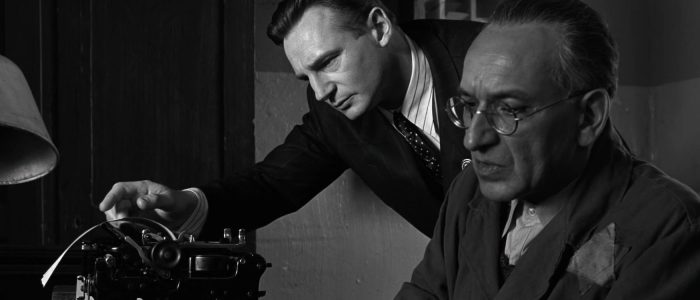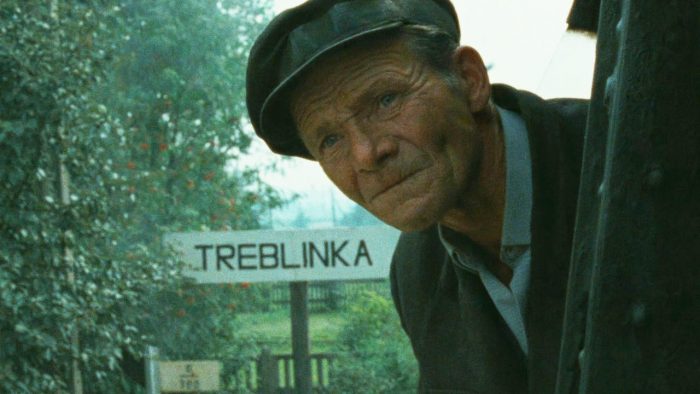
Two of the 20th century’s greatest films are bound together by the same historical tragedy. When it arrived in theaters in mid-December 1993 — just six months after his summer blockbuster, Jurassic Park — critics and audiences alike embraced Steven Spielberg’s Schindler’s List as a masterpiece. More than just an awards season drama, the film provided what’s been called a “first foundational encounter with the Holocaust” for a whole generation of viewers. It soon emerged as the crowning achievement in Spielberg’s career, earning him his first Best Director Oscar and his only Best Picture Oscar. In 1998, a mere half-decade after its release, Schindler’s List placed in the top ten on the American Film Institute’s list of the 100 greatest American movies of all time.
The movie had its detractors, however. Not everyone was enamored of Spielberg’s dramatic approach to the weighty, real-life subject matter. One of the most vocal critics was Claude Lanzmann, a French filmmaker known for his own landmark Holocaust documentary, Shoah. Released in 1985, Shoah helped inspire the pseudo-documentary look of Schindler’s List. In 2012, it was this film, not Spielberg’s, that showed up in the results of the British Film Institute’s once-a-decade poll of the 50 greatest films of all time. Yet when Shoah was commemorating its own 25th anniversary back in 2010, Lanzmann lamented to The New York Times that his film had “disappeared from the American scene.”
Earlier this year, Lanzmann passed away, and now all eyes are on Schindler’s List again as we recognize the quarter century that has passed since its release. Recent world events have made both of these films more relevant than ever, and rather than be at odds, Schindler’s List and Shoah stand as necessary companion pieces in the preservation of Holocaust awareness.

The Sobering Testimony of Shoah
While Schindler’s List is based on a true story, it is very much a dramatization of that story, as opposed to a straight documentation. This makes it intrinsically different from Shoah, which relies solely on interviews, the living testimony of real Holocaust survivors. Yet the way Schindler’s List ends, with survivors and the actors who portrayed them visiting Schindler’s grave, it could almost flow directly into Shoah’s interviews. The two movies might be ideally paired as a double feature, with each film illuminating different aspects of the other.
Eschewing the standard format of other historical documentaries like Ken Burns and Lynn Novick’s recent The Vietnam War, Shoah does not even make use of old newsreels. Interspersed among the talking survivor heads, the only location footage we see is that of actual sites in Poland as they existed years after World War II.
Roger Ebert described Shoah as “an act of witness,” and in a way, it does put the viewer in the position of a juror, sitting in on a trial (whereas Schindler’s List makes the viewer an audience member, watching a skillful reenactment). Playing interviewer, Lanzmann attempts to reconstitute history from oral accounts and the examination of documents like a train schedule to extermination camps.
In an era where podcasts and Netflix documentary series such as Serial and Making a Murderer have enjoyed great success packaging true crime as entertainment, Shoah is ripe for rediscovery as something more than that. It takes a similar investigative approach to one of the most heinous crimes ever perpetrated against humanity. It’s less sensationalistic, however, because in this case, we know who the murderers are, and Lanzmann is not interested in parceling out cliffhangers or asking big profound questions about the why of it all (as if any justifiable meaning could be extracted from a crime so senseless).
Soul-searching is left to the viewer, not some chatty narrator. Lanzmann is more concerned with forming a mosaic of nitty-gritty details to illustrate the precise reality of how the Holocaust happened.
In the past, one hurdle that might have impeded viewership with Shoah is its epic length. If you thought Schindler’s List was long at three hours and fifteen minutes, Shoah clocks in at over nine hours. While the BBC has broken it up into two 4.5-hour episodes for broadcast purposes before, it generally is regarded as a movie and hasn’t stirred debate about feature-film length the way the documentary O.J. Made in America did a couple years ago. The trend of binge-viewing nowadays makes it a less daunting watch, but the fact is, Shoah does make a significant time demand of the viewer and people with short attention spans might not have the patience to commit to it.
Those who do commit to it and who are coming at it from a place where Schindler’s List is their primary cinematic reference for the Holocaust will find that Shoah immediately has a sobering effect. It snaps the viewer out of any Hollywood reveries and anchors him or her to cold, hard history. The testimonies given elicit a mixture of disbelief, pity, and outrage, the kind of righteous indignation that comes from being confronted by the knowledge that an institutionalized evil really happened.
That evil was sanctioned and enabled not by cartoon villains but by people who simply adjusted their normal mode of living to facilitate an atrocity. As distant as the 1940s might seem, we’re only decades removed from a time when banal, bureaucratic actions led to the unthinkable in seemingly civilized countries. The image in Schindler’s List of a road paved with gravestones is an apt visual metaphor for how man’s inhumanity toward man solidifies step by step.
One of the most astute observations in Shoah comes from a historian who notes, “The key to the entire [Nazi] operation from a psychological standpoint was to never utter the words that would be appropriate to the action being taken.” This is how the Nazis carried out their “Final Solution of the Jewish Question,” which itself was a code name for the systematic genocide that would claim two-thirds of Europe’s Jewish population before World War II was over. In addition to Jewish people, of course, Romani people, ethnic Poles, homosexuals, and other groups deemed sub-human by the Nazis suffered their own mass killings.
In Schindler’s List, when German businessman Oskar Schindler, played by Liam Neeson, first sits down with Nazi SS officer Amon Goeth, played by Ralph Fiennes, we notably hear Goeth venting about the paperwork and permits required to set up a “sub-camp” where Schindler can utilize Jews as factory workers. For him, the business of the Holocaust is a job like any other. Everyone has his or her part to play.
The job of the real-life train worker on the Shoah movie poster was to bring victims to the extermination camp at Treblinka. As he was leading the convoy of train cars into the camp, he would signal to the other cars by drawing his finger across his throat in a slashing motion.
Schindler’s List remixes the reality of this into a movie scene. When the train full of female workers in Schindler’s factory gets rerouted to Auschwitz, one of the women on board looks out the window to see a Polish child making the same ominous hand gesture.
Continue Reading ‘Schindler’s List’ and ‘Shoah’: How Two of the 20th Century’s Greatest Films Illuminate Each Other >>
The post ‘Schindler’s List’ and ‘Shoah’: How Two of the 20th Century’s Greatest Films Illuminate Each Other appeared first on /Film.
from /Film http://bit.ly/2Q35VlK
via IFTTT
Comments
Post a Comment